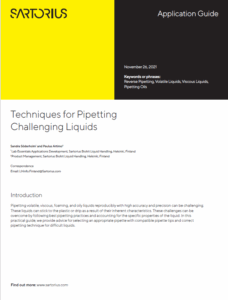Handling challenging liquids, such as viscous, foaming, volatile, or oily samples, can compromise pipetting accuracy, introduce variability, and slow down workflows. These substances behave unpredictably, often clinging to pipette tips or dripping during transfer, leading to inconsistent results. This application guide is designed to help laboratory professionals address these common frustrations.
Whether you are pipetting solvents in analytical chemistry, oils in materials testing, or viscous reagents in molecular biology, this resource provides practical recommendations to enhance technique and improve consistency.

What this guide covers:
- How to identify the unique challenges of volatile, viscous, foaming, and oily liquids
- Strategies for selecting the right pipette and tip combination for each liquid type
- Step-by-step guidance on adjusting your technique to improve accuracy and minimize waste
- Tips to increase reproducibility across replicates and operators
This guide is ideal if you:
- Work in a contract laboratory or third-party testing facility with diverse sample types
- Handle complex matrices that require precision liquid handling
- Are training new staff on pipetting technique for non-standard fluids
- Aim to reduce pipetting errors and increase overall lab efficiency
Get the resource now!
Whether you’re troubleshooting recurring pipetting issues or standardizing methods across your team, this guide offers proven techniques to support reliable results, even with the tricky liquids.
Ace at pipetting challenging samples. Complete the form and download the guide right away.
